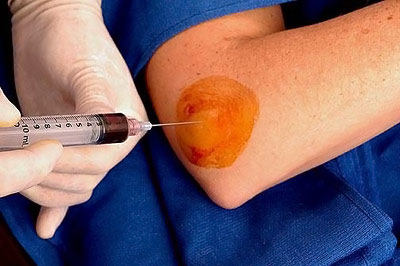Cortisone injections help reduce inflammation and relieve pain in an area of the body, such as the joints (ankle, elbow, knee, shoulder, hip, spine or wrist). These injections, which are usually given at a doctor's office, usually contain a corticosteroid and some local anesthetic. However, some people experience pain after the injection.

Pain After Cortisone Injection: Why and What to Do
Cortisone flares cause pain after the cortisone injection. These usually occur 24 to 48 hours after the shot has been given. What causes the cortisone flare?
- The needle puncture which pierces through your skin and causes pain and inflammation
- Crystallization which comes from the injected cortisone, leading to irritation to the soft tissue and the lining of the joints
How to Soothe the Pain
- Rest the affected area. If you experience pain after the injection, rest the area to reduce inflammation. Avoid engaging in strenuous activity.
- Apply ice a few minutes to the area for a few days. This is an effective way to reduce cortisone flares.
- Take anti-inflammatory medication. Ask your doctor for advice on what medication to take to reduce pain after cortisone injection.
When Will the Pain Stop?
Cortisone flares often do not last long. They typically disappear within a few hours or a few days, since cortisone itself works by reducing inflammation. However, if the pain worsens despite treatment, contact your doctor immediately.
Other Possible Effects of Cortisone Injection
1. Elevated Blood Sugar Levels
Diabetic patients may experience an elevation in their blood sugar levels after a cortisone injection. It is therefore advisable to carefully monitor your blood sugar if you are diabetic. If you are taking insulin, check your blood sugar levels often to see if you need to adjust insulin doses.
2. Facial Flushing
A flushing sensation in the face is another common reaction, especially in women. It may begin after a few hours after the injection and last for days. Although this may upset some patients, it usually resolves spontaneously.
3. Infection
An injection causes a break in your skin, which may increase your chances of infection. Properly sterilizing the skin to reduce the risk of infection is therefore important.
4. Skin Pigment Changes
Besides pain after cortisone injection, other side effects can also result. Patients with dark skin may notice lightening of their skin near the injection site. Fortunately, this is not a harmful situation.
5. Loss of Fatty Tissue
A high dose of cortisone injection causes fat atrophy, or loss of fat tissue around the area of injection. This can cause dimpling of your skin or thinning out of the fat. Cortisone injections in the heels for plantar fasciitis may cause pain while walking, because the fat that cushions the heels is thinned out.
6. Tendon Rupture
Cortisone injections can cause weakening of the tendons. For this reason, doctors may limit frequency of cortisone injections. Cortisone injection may also lead to tendon rupture, causing tendonitis.
7. Allergic Reaction
Allergic reactions to local anesthetic in the injection are not common, but they can happen. On the other hand, allergy to cortisone itself is rare, since cortisone is similar to cortisol, a naturally occurring steroid found in your body.
What Can You Do About the Side Effects?
Consult your doctor if you experience pain after cortisone injection or other side effects. If you have had any unusual reactions in your previous injections, tell your doctor so that he/she can decide whether or not you can have another cortisone injection.
Aftercare Tips for Cortisone Injection
- Protect the area by not using the joint for any activity, such as heavy lifting or walking.
- Apply ice as often as needed to reduce pain and inflammation. Avoid heating pads.
- Watch out for any sign of infection, such as redness, increasing pain, or swelling that lasts more than 2 days.
- Use the shower and avoid using a hot tub, bathtub, or whirlpool for 2 days.
Alternative Treatments to Cortisone Injection
If you always experience serious side effects after receiving the injection, here are other treatments to consider to relieve your pain.
- Platelet Rich Plasma (PRP) Therapy can be used to treat osteoarthritis and chronic pain. This involves taking a small amount of your blood and separating the platelets which are re-injected into the affected joint to stimulate repair of damaged tissue.
- Stem Cell Therapy works by taking your own fat deposit around the hip or stomach and re-injecting it into the affected area where damaged tissue is present. The new fat cells help heal and stimulate growth of new tissues at the injured site. Side effects are rare with stem cell therapy.
- Viscosupplementation involves injecting a lubricated gel between 2 rubbing bones using image guidance technology. It usually reduces pain completely, but additional treatment may be necessary, since its effects are temporary.
- Medical Ozone Therapy is a homeopathic treatment that involves injection of substances into an injured area, followed by treatment with minerals and vitamins to accelerate healing. Finally, ozone is introduced gradually to the affected area.
